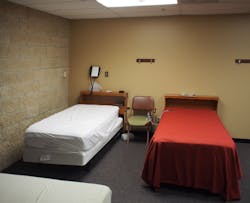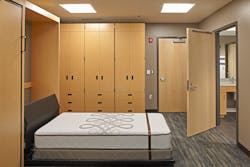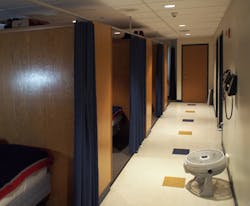Sleep deprivation, fatigue and decreased alertness among first responders are problems receiving significant attention in the fire service media, and rightly so. Studies have identified some of the key implications of sleep deprivation and sleep disorders, and they are sobering.
Sleep stats
According to a recent study, 37 percent of firefighters show signs of a sleep disorder, the majority of which are undiagnosed and untreated.1 Furthermore, firefighters face increased risks of chronic health issues, and sleep deprivation compounds the issue. Firefighters with sleep disorders are 2.4 times more likely to have cardiovascular disease, 1.9 times more likely to have diabetes, and 3 times more likely to have depression or anxiety disorders.1 More broadly, sleep loss associated with shift work has been shown to significantly increase relative risks for cancer and stroke.2
Mental functioning is severely diminished without proper sleep. Only getting 5 hours of sleep for four consecutive days, instead of the recommended 7–9 hours, has cognitive effects similar to a blood-alcohol concentration of .06 percent.3 Fireground injuries are more likely to occur between 12 a.m. and 6 a.m. than at any other time of day.4 Firefighters diagnosed with sleep deprivation are twice as likely to be involved in a motor vehicle accident.1 Additionally, sleep deprivation has been linked to theft or destruction of employer property,5 verbal abuse of co-workers,6 susceptibility to unethical suggestions,7 impulsive behavior,8 and a general lack of emotional restraint.6
The myriad impacts of poor sleep amount to a serious safety concern, but is also a significant area of liability for departments whose firefighters are experiencing these symptoms. We know that there is no simple solution to sleep disorders, even as widespread as they are. Part of the solution is policy related, but another is directly attributable to the built environment.
The way your firehouse is designed and constructed plays a significant role in the quality of sleep firefighters can hope to achieve. Most fire stations are old, small and designed for an era with fewer calls, and unless they were forward-thinking, they were not designed to promote good sleep. Fortunately, there are many alterations that can be made to the physical space that will allow you and your crew to get better sleep on nights when the calls slow down. Let’s review several contributing factors to poor sleep and some solutions for each.
Light
The brightness and color profile of light has a direct impact on our internal clock. Various hormones rise and fall in response to these cues, so lighting can be used to communicate to our bodies that it is time for sleep.
An ambitious alteration project might replace light fixtures in portions of the station with cutting-edge LED technology that can echo the subtle color variations that natural sunlight goes through each day, from cool tones in the morning to softer reddish tones late in the day. These color-adaptive fixtures, now gaining popularity in residential settings, provide extra environmental cues to wind the body’s hormones toward a restful night. Providing better access to daylight during the day also serves to align your body’s internal clock, so installing skylights and light tubes or cutting in additional windows throughout the station can notably improve sleep.
Control of the light levels in your sleeping area is important. The best-case scenario would provide each firefighter with a separate room and a dimming switch for precise light level controls, and in some large stations, this may be a feasible retrofit. In a group dormitory arrangement or a room without full-height walls between bunks, each sleeping space should be provided a small LED task light to allow reading or getting ready for bed without turning on the overhead lights and disturbing the entire room. Similarly, it is a common practice to install step lights in fire station corridors to provide enough light to reach the restroom without the bright overhead fixtures jolting you back to full alertness. These fixtures are an easy addition to a building, with battery-powered options available. Light levels in restrooms should be on dimmer controls, with an occupancy sensor controlling a low-level fixture and manual control for more light if desired.
Rolling blackout shades are a critical and inexpensive amenity for sleeping areas. Even stations that are not bothered by car headlights, streetlights or building security lighting can benefit from this alteration if firefighters occasionally sleep late after a call the night before. Any frequent visitor to fire stations has seen ad hoc solutions to this problem that may or may not be building code compliant. Properly installed blackout shades are opaque even in bright sunlight, and run in tracks or channels at the window jambs, preventing light spillage around the edges.Another option is to alter your alerting system to only turn on lights specific to the crews that are responding to the call instead of for the entire station. If your existing system doesn’t allow that, consider tying the system into a dedicated light fixture with a red filter. This way, blue wavelengths don’t confuse your body into thinking it is time to be awake.
Sound
Loud noises create an instant adrenaline response, but even consistent low-level noise can be sufficient to prevent sleep. In an ideal scenario, each firefighter will have independent control of the sound level in their sleeping space to suit their needs, such as using a white noise machine or resting in complete silence.
Physical distance from the source of noise is the most foolproof way to reduce decibel levels, but a barrier with sufficient mass can also dampen sound transmission. However, sound travels well through even the smallest holes, so partial-height separations will have almost no effect on the transfer of sound between bunks (although they are beneficial for other reasons). Even full-height walls are imperfect if they are not caulked at the perimeter with acoustic sealant or if they don’t have a door with perimeter gasketing.
In large dormitory-style bunk rooms, or even a single-user room where a firefighter occasionally snores himself awake, sound absorption can be an effective strategy. Absorptive ceiling tiles are inexpensive and can be very effective if they are maintained properly. Window curtains will also contribute to sound absorption, but are slightly less effective at mitigating sound transfer through the window than the same blackout shades with perimeter channels mentioned above. In group sleeping rooms, white noise at a reasonable level (no more than 65 decibels, according to some experts) can sufficiently mask noise to keep the tossing and turning of coworkers well below the level of notice.
At the least, frequent sources of loud noises should be minimized. All the doors near the sleeping spaces should be fitted with jamb silencers to prevent slamming. Lockers located near the sleeping areas should have silencers as well. If possible, the alerting system should notify only the rooms occupied by the crew leaving on the call, leaving other firefighters blissfully asleep.
Even vibration from industrial work, nearby highways or somebody dropping weights in the physical conditioning room down the hall can disturb sleep. Different strategies are appropriate for mitigating different types of vibration, but beds are less likely to transmit vibration than built-in platforms that are securely attached to walls and floors.
Thermal comfort
It is documented in other areas of human comfort research that differences in biology, metabolism, clothing and physical size result in massive changes to perception of thermal comfort, and this remains true while people are asleep. While science shows that cool air temperatures are ideal, feeling too cold can cause poor sleep. Providing individual temperature controls within individual bunk rooms is unrealistic on most budgets, but wall diffusers with integral re-heating coils are readily available, and a simple alteration could simply be providing individual electrical circuits for each bunk space to provide capacity for small space heaters.
Air movement is a key thermal comfort variable, so installing a ceiling fan for each bunk space allows control of air speed without freezing out the next bed over. The effects of radiant heat and drafts due to insufficient insulation in the exterior walls or poorly performing windows are important to consider, as they frequently cause an uncomfortable temperature gradient from one side of the body to the other. This may require additional insulation on the interior side of the wall or, if a window is the issue, your blackout shade with guide tracks can provide an extra barrier to heat transfer.
Humidity is another factor in perceived temperature, and proper control of humidity can be a major factor in promoting good sleep. Insufficient humidity can be addressed by adding humidifiers onto the mechanical system and providing the necessary maintenance. Most excess humidity issues are the result of poor ventilation in shower areas, which can be resolved with a more powerful exhaust fan, or caused by holes in the building envelope allowing humidity to infiltrate the enclosure. The latter is a more difficult problem to fix, but it can be tackled with a caulk gun and a thermal imaging camera and will provide savings in your energy bills as well.
Texture and posture
While not traditionally considered a dominant sense, when in a quiet room with eyes closed, a person’s touch receptors occupy a large portion of the brain’s attention. Finding the right bedding ensemble that allows those receptors to rest peacefully is essential to sleep. Many full-time departments issue blankets, sheets and pillows to their staff for sleeping and most provide mattresses, all of which guarantee that no one is completely happy. Mattresses should be sized appropriately to the firefighter, be adjustable from firm to soft, or be constructed of supportive foam designed by a chiropractic or sleep professional. Providing separate murphy beds for each shift so each firefighter can select their individual mattress is another option. Providing a bed cover for consistent appearance during waking hours is fine, but firefighters should supply their own pillow, sheets and blankets that provide the softness or stiffness, silkiness or scratchiness, heaviness or lightness that they prefer. Sleeping wedges to elevate the back and body pillows for side sleeping support may require more storage space than traditional lockers accommodate, but if they improve sleep outcomes for firefighters who use them, they are well worth the cost of a second locker.
Peace of mind
Departments cannot eliminate mental stress from their employees, but they can provide space that satisfies our innate desire for physical protection, giving us one less thing to worry about when we sleep. Most people need more personal space when sleeping than when awake, and defining the boundaries of that space and providing a wall at your back is a simple strategy. If full-height walls are cost prohibitive or not feasible for other reasons, try using wardrobe cabinets, lockers, furniture or short walls to provide individual cubbies for each firefighter on shift. Doors that separate the cubbies from common areas are best practice, but even a curtain is better than leaving the entry completely open. Sleep experts recommend personalization of your sleeping space to create an environment that is visually associated specifically with sleep and security, so encourage firefighters to fill the walls with posters and provide shelves for memorabilia.Another key to reducing mental stress is a clean sleeping room. To put it delicately, we all have different internal thresholds of what constitutes appropriate personal hygiene. These individual differences are a frequent source of conflict, so a space that is easy to effectively clean each morning becomes essential. Ideally the floor should be a hard surface that can be swept and mopped, potentially with some small rugs that can fit into the washing machine. Even if it is accomplished through off-the-shelf HEPA air purifiers, the room should be well-ventilated to remove unpleasant smells and allergens. If the windows are operable, check the seals to make sure dust and dirt aren’t making their way in. If space and budget allow, individual murphy beds for each shift provides the peace of mind that comes from not sharing a mattress. And of course, the sleeping areas should be physically removed from the apparatus bays and any potential cross-contamination should be prevented with an air lock and appropriate exhaust air balancing.
In sum
Many of the approaches discussed above can be achieved as a small improvement project with materials purchased via discretionary funds and installed by staff. Others are more appropriate as part of a comprehensive station renovation, designed by an architect who has studied sleep hygiene and the relevant research and bid out to a contractor. But whether the project is large or small, the benefits to your firefighters and to the citizens you protect will be real. While more research remains to be done and a broader industry-wide strategy has not yet been defined, we can immediately implement incremental changes with the confidence that we are helping our firefighters sleep better, thereby helping them to serve the citizens they are charged with protecting.
References
1. BIBLIOGRAPHY \l 1033 Barger, L, Rajaratnam, S, Wang, W, et al. "Common sleep disorders increase risk of motor vehicle crashes and adverse health outcomes in firefighters." Journal of Clinical Sleep Medicine, 233–240 (2015).
2. Kecklund, G & Axelsson, J. "Health consequences of shift work and insufficient sleep." The BMJ (2016).
3. Elmenhorst, D, Elmenhorst, E, Luks, N, et al. "Performance impairment during four days partial sleep deprivation compared with the acute effects of alcohol and hypoxia." Sleep Medicine, 189–197 (2009).
4. Elliot, D, & Kuehl, K. "Effects of Sleep Deprivation on Fire Fighters and EMS Responders." International Association of Fire Chiefs (2007).
5. Christian, M, & Ellis, A. "Examining the Effects of Sleep Deprivation on Workplace Deviance: A Self-Regulatory Perspective." Academy of Management Journal, 913–934 (2011).
6. Barnes, C, Lucianetti, L, Bhave, D, & Christian, M. "'You Wouldn’t Like Me When I’m Sleepy': Leaders’ Sleep, Daily Abusive Supervision, and Work Unit Engagement." Academy of Management Journal, 1419–1437 (2015).
7. Welsh, D, Ellis, A, Christian, M, & Mai, K. "Building a self-regulatory model of sleep deprivation and deception: The role of caffeine and social influence." Journal of Applied Psychology, 1268–1277 (2014).
8. Kilgore, W, Kahn-Greene, E, Lipizzi, E, et al. "Sleep deprivation reduces perceived emotional intelligence and constructive thinking skills." Journal of Sleep Medicine, 517–526 (2008).
About the Author

Craig Carter
Craig Carter, AIA, LEED AP BD+C, is lead facility planner and firematic expert with BKV Group, which is a full-service design firm that has offices around the country. Carter has 21 years of experience in architectural design, documentation and construction administration with a focus on public-safety projects. He has worked on more than 80 fire station projects and won several design awards that celebrate the functionality and beauty of the projects. Carter combines a deep knowledge of the history of public-sector design with an up-to-date knowledge of the latest national trends.


